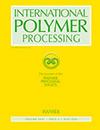光电器件用聚氯乙烯/铜氧化铝纳米复合材料的光学和温度相关电学特性
IF 1.9
4区 工程技术
Q4 ENGINEERING, CHEMICAL
引用次数: 1
摘要
摘要聚氯乙烯的热稳定性差、介电常数低、不能屏蔽紫外线等缺点限制了它的实际应用。在这项研究中,我们尝试使用铜氧化铝(Cu-Al2O3)纳米颗粒增强聚氯乙烯(PVC)来改善光学性能、热稳定性、温度依赖性电导率和介电常数。用紫外可见光谱仪测量的光学吸收强调了与PVC相比,PVC/ Cu-Al2O3纳米复合材料在吸收边的蓝移和带隙能量的降低。用红外光谱法证实了Cu-Al2O3在聚氯乙烯中的存在及其与聚合物的相互作用。热重分析(TGA)表明,纳米复合材料具有比PVC更高的热稳定性,且热稳定性随填料的增加而增加。扫描电子显微镜(SEM)显示纳米Cu-Al2O3在聚合物基体中的均匀分散。由阿伦尼乌斯方程确定的活化能表明,随着纳米粒子的加入,交流电导率增加到特定的负载。介电常数随温度而增大,随频率而减小。负载7 wt%的纳米复合材料的交流电导率和介电常数最大。Bruggeman和Maxwell-Garnet模型预测的介电常数与实验介电常数吻合较好。通过阻抗分析研究了纳米复合材料的半导体性质。Cole-Cole图的半圆形特性体现了并联电容与低体电阻的结合。聚氯乙烯/ Cu-Al2O3纳米复合材料的光学、热学、电学和介电性能得到增强,可用于制造具有优异电荷存储能力的光电器件。本文章由计算机程序翻译,如有差异,请以英文原文为准。
Optical and temperature dependent electrical properties of poly (vinyl chloride)/copper alumina nanocomposites for optoelectronic devices
Abstract The practical applications of poly (vinyl chloride) have been constrained due to its poor thermal stability, low dielectric constant and inability to shield against ultraviolet (UV) radiation. In this study, we tried to improve the optical properties, thermal stability, temperature-dependent electrical conductivity and dielectric constant using copper alumina (Cu–Al2O3) nanoparticles reinforced poly (vinyl chloride) (PVC). Optical absorption measured with an ultraviolet-visible (UV-visible) spectrometer emphasises the blueshift in absorption edges and decreasing bandgap energies of PVC/Cu–Al2O3 nanocomposites compared to PVC. The presence of Cu–Al2O3 in PVC and its interaction with the polymer were confirmed by FTIR spectroscopy. Thermogravimetric analysis (TGA) demonstrates that nanocomposites have higher thermal stability than PVC, and that thermal stability increases with filler loading. Scanning electron microscopy (SEM) indicates the homogeneous dispersion of nanosized Cu–Al2O3 in the polymer matrix. The activation energy determined by the Arrhenius equation revealed that AC conductivity increases with the addition of nanoparticles up to a specific loading. The dielectric constant increases as a function of temperature and decreases with frequency. The magnitude of AC conductivity and dielectric constant were highest for 7 wt% loaded nanocomposites. The dielectric constant predicted by the Bruggeman and Maxwell-Garnet models were in good agreement with the experimental permittivity. The semiconducting nature of nanocomposites was investigated by impedance analysis. The semi-circular nature of Cole-Cole plots manifests the combination of parallel capacitance with low bulk resistance. The enhanced optical, thermal, electrical and dielectric properties of PVC/Cu–Al2O3 nanocomposites can be utilized in fabricating optoelectronic devices with excellent charge-storing ability.
求助全文
通过发布文献求助,成功后即可免费获取论文全文。
去求助
来源期刊

International Polymer Processing
工程技术-高分子科学
CiteScore
2.20
自引率
7.70%
发文量
62
审稿时长
6 months
期刊介绍:
International Polymer Processing offers original research contributions, invited review papers and recent technological developments in processing thermoplastics, thermosets, elastomers and fibers as well as polymer reaction engineering. For more than 25 years International Polymer Processing, the journal of the Polymer Processing Society, provides strictly peer-reviewed, high-quality articles and rapid communications from the leading experts around the world.
 求助内容:
求助内容: 应助结果提醒方式:
应助结果提醒方式:


